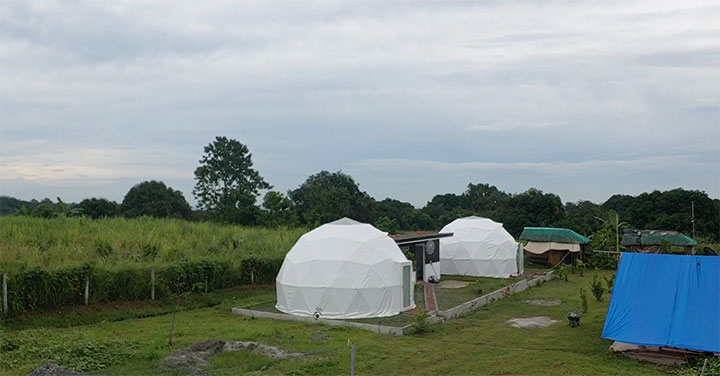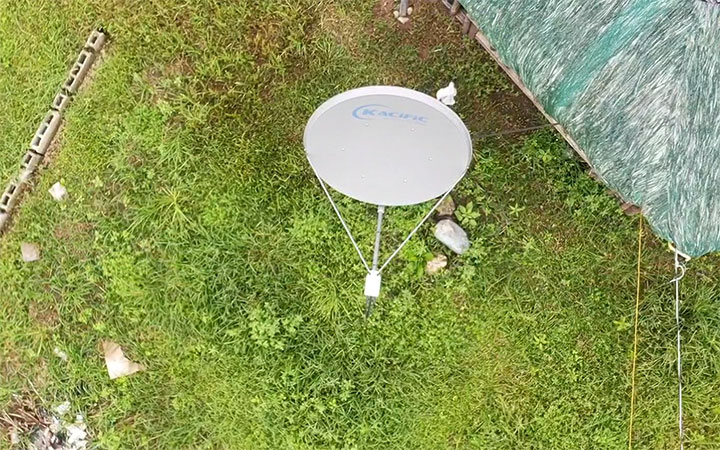Earlier this year, we had a satellite internet service installed at our farm in New Clark City. It’s been more than 6 months now and we continue to enjoy fast broadband internet in the location. It was for this reason (among others) that we were confident about constructing the YugaTech Campus in the area since internet is one of the many factors we had to consider before we pushed thru with the project.

You can read more about our initial impressions of Kacific Internet here when we first installed it. Now, we’d like to do a more long-term review of the service to give you a better perspective should you look into getting a similar setup.

Table of Contents
When we had the satellite internet first installed earlier this year, we did several speed tests. Most of the time, we were hitting somewhere between 30 – 40Mbps (download) any time of the day. In the evenings, we could sometimes get results as fast as 70Mbps which is really good.

These days, we are still getting around 30Mbps average download speeds. For most of our needs, this is already reasonable. We were playing YouTube and Netflix on one of the smart TVs installed in the staff quarters and so far, the experience is pretty smooth.

What is really a bigger concern for us in terms of speed is the upload since we are regularly storing large video files in our team Dropbox and remote NAS. The 2 to 3Mbps upload speed will take us a while to finish a YouTube upload (around 30 minutes for a single video).
The satellite dish came with an Asus router for wider WiFi coverage. The coverage is pretty wide and the signal managed to reach the entire perimeter of the campus which was 10,000sqm.

Since then, we installed additional repeaters or AP routers to increase signal strength on some parts of the property.
In terms of the satellite service, service is pretty much available anywhere in the Philippines. All you need is a clear line-of-sit of the skies with little to no obstruction from structures (buildings) or the landscape (mountains, trees, etc.)

The satellite dish can even work with solar power so operation will not be a problem even if you don’t have the usual source of electricity in your location.
One of our biggest concerns when having this type of internet in far-flung locations is consistency and uptime. Uptime refers to how often are we going to have internet access (vs. downtimes) and consistency refers to how often are we going to get good, fast internet due to external factors like weather. Issues such as rain fade (absorption of a microwave radio frequency or RF signal by atmospheric rain) come to mind. So far, we have not had any major issues with both uptime and consistency.

Perhaps, the biggest incident we have had in the past 6 months was during the time of Typhoon Karding (Super Typhoon Noru). During that time, Tarlac was under Signal No. 4 and we monitored the condition of the campus remotely via the installed outdoor CCTV. In the first few hours that the typhoon landed in Tarlac, internet connection was still good and consistent but it was disconnected around early in the evening. This was actually due to power loss from felled electric poles in the area but when we turned on the back-up generator, the internet connection was up and the we were able to monitor the condition via the CCTVs again.
Satellite internet is not a perfect solution for our situation but it is the best solution we could do at the moment. It was fast and easy to install; we got our internet service within 24 hours. Download speed is more than enough for our needs.
As for pricing, it is not cheap but reasonable. Satellite internet used to be very expensive and slow. Kacific Internet offers a wide range of packages ranging from 3Mbps to 100Mbps, depending on your needs and budget.
You can check more about their service here.

YugaTech.com is the largest and longest-running technology site in the Philippines. Originally established in October 2002, the site was transformed into a full-fledged technology platform in 2005.
How to transfer, withdraw money from PayPal to GCash
Prices of Starlink satellite in the Philippines
Install Google GBox to Huawei smartphones
Pag-IBIG MP2 online application
How to check PhilHealth contributions online
How to find your SIM card serial number
Globe, PLDT, Converge, Sky: Unli fiber internet plans compared
10 biggest games in the Google Play Store
LTO periodic medical exam for 10-year licenses
Netflix codes to unlock hidden TV shows, movies
Apple, Asus, Cherry Mobile, Huawei, LG, Nokia, Oppo, Samsung, Sony, Vivo, Xiaomi, Lenovo, Infinix Mobile, Pocophone, Honor, iPhone, OnePlus, Tecno, Realme, HTC, Gionee, Kata, IQ00, Redmi, Razer, CloudFone, Motorola, Panasonic, TCL, Wiko
Best Android smartphones between PHP 20,000 - 25,000
Smartphones under PHP 10,000 in the Philippines
Smartphones under PHP 12K Philippines
Best smartphones for kids under PHP 7,000
Smartphones under PHP 15,000 in the Philippines
Best Android smartphones between PHP 15,000 - 20,000
Smartphones under PHP 20,000 in the Philippines
Most affordable 5G phones in the Philippines under PHP 20K
5G smartphones in the Philippines under PHP 16K
Smartphone pricelist Philippines 2024
Smartphone pricelist Philippines 2023
Smartphone pricelist Philippines 2022
Smartphone pricelist Philippines 2021
Smartphone pricelist Philippines 2020